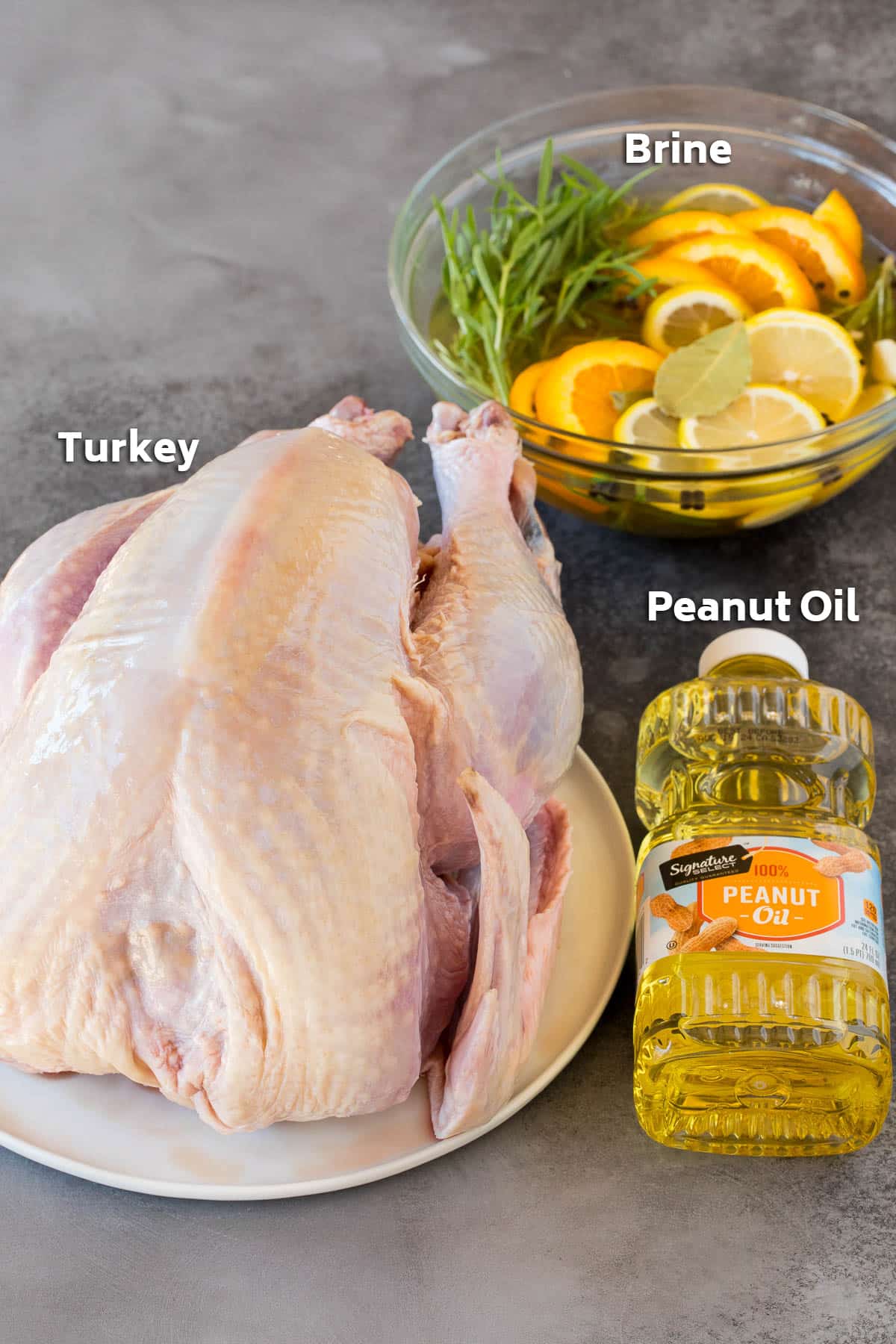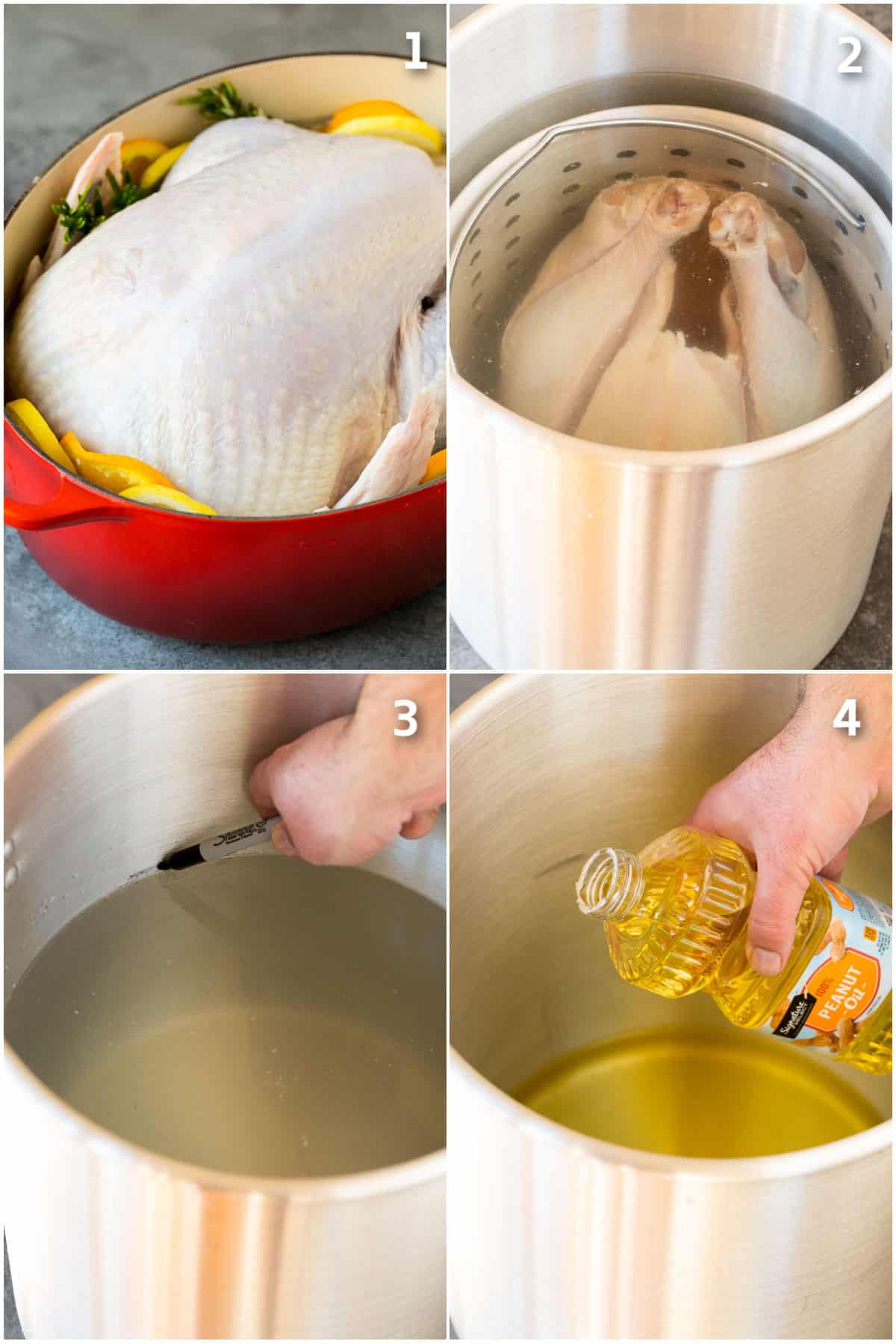This deep fried turkey is brined in a mixture of herbs and citrus, then fried to golden brown perfection. Fried turkey is crispy on the outside, and juicy and tender on the inside. The best way to prepare your holiday meal when you’re short on oven space!
Looking for something a little different to serve at Thanksgiving this year? Try a fried turkey, along with homemade cranberry sauce, sweet potato casserole, corn pudding and green beans almondine, for a memorable meal that will earn you rave reviews.
I always find myself running out of oven space when I’m making a big meal. I decided to try frying my turkey instead of roasting it, and the results were fantastic. Deep fried turkey cooks in a fraction of the time and the flavor just can’t be beat!
Fried turkey has become a popular alternative to traditional roasted turkey prized for its juicy meat and crispy skin. But can you successfully deep fry a turkey that’s been brined first? The answer is yes with proper precautions. This article provides tips on brining, frying and safely cooking your bird.
Why Brine Before Frying?
-
Brining makes turkey moist and flavorful. The salt solution enhances juiciness and seasons the meat. This effect is amplified in frying’s hot oil.
-
Brines often contain spices, herbs and citrus. These infuse the turkey with extra flavor.
-
Brining plumps up the cells, meaning better texture. This also improves crisping when fried
-
Cured and brined meats withstand frying heat better. The salts have a protective effect.
-
Overall, brining before frying boosts both texture and taste. The turkey will be even more succulent than frying alone.
Choosing a Brine
-
Simple brines use just salt, sugar and water. Add aromatics like peppercorns, herbs and citrus slices.
-
Spice blends like Cajun seasoning, jerk or curry mixes complement fried turkey beautifully.
-
Sweet brines with brown sugar or honey lend wonderful caramelized notes when fried.
-
Savory brines made with chicken or turkey stock infuse tons of flavor.
-
Avoid very acidic brines from lots of citrus, vinegar or wine, as they can toughen meat.
-
Make sure brine fully penetrates meat. Inject thick breasts and legs for best results.
Brining Tips
-
Brine turkey 12-24 hours for ideal seasoning. Longer can make it too salty.
-
Keep turkey submerged and chilled at 35-40°F. Use a cooler or fridge space.
-
Estimate 1 cup salt per 1 gallon water. Adjust to taste. Add sugars, spices and aromatics.
-
Rinse turkey after brining, and pat very dry. Moisture causes hot oil to bubble up.
-
Let turkey rest after brining to allow moisture and salts to set. Pat dry again before frying.
Frying Your Brined Bird
-
Heat oil to 350-375°F. Use a deep fry thermometer for accuracy.
-
Lower turkey slowly into hot oil to prevent splattering. Fry 3-5 minutes per pound.
-
Oil will bubble up initially. Allow it to settle before lowering turkey farther.
-
Brined turkeys cook faster than unbrined. Monitor temperature and adjust time down if needed.
-
Frying gives an instant 165°F, but still verify doneness with a meat thermometer.
-
Rest fried turkey at least 20 minutes before carving for juiciest meat.
Safety Tips
-
Never fry a frozen or partially frozen turkey. Ice leads to dangerous splatter. Always brine and fry fully thawed birds.
-
Avoid overfilling the pot with oil. Leave several inches of headroom. Overflow can ignite on gas or electric heat sources.
-
Use a pot thermometer to monitor oil temp. Maintain consistent heat for ideal cooking.
-
Keep the fryer outside on a flat surface away from structures or trees. Have an extinguisher on hand just in case.
-
Wear long sleeves and closed toe shoes for protection from splatter. Keep kids and pets safely away.
Make It a Fried Feast
Brined, fried turkey is delicious on its own, but takes sides to new heights:
-
Crispy fried okra, green tomatoes or pickles suit the Southern theme.
-
Make mac and cheese extra decadent with a bit of reserved frying oil.
-
Fry leftover turkey nuggets for amazing sandwiches and snacks.
-
Drizzle hot fried turkey with spiced honey, buffalo sauce or other glazes.
With the right prep and safety steps, brined and fried turkey is a revelation. The hot crisp shell seals in seasoned, succulent meat that proves this dish isn’t just for special occasions. A brined bird can make your next everyday fried turkey supper the best ever.

Deep Fried Turkey Ingredients
This fried turkey recipe calls for a batch of my homemade turkey brine, a turkey and oil for frying such as peanut oil.

How Do You Make Deep Fried Turkey?
Remember to read all the instructions and safety tips in this post and in the recipe card. To deep fry a turkey first make make a good brine that will infuse the turkey with flavor before it cooks. Make my favorite turkey brine which is savory, sweet and flavored with herbs and citrus notes. Remove the neck and giblets from the turkey. Place a thawed 12-15 pound turkey in the brine for 18-24 hours and place it in the fridge.
Remove the turkey from the brine, rinse it off and take off any ties on the drumsticks. Pat the bird dry. Make sure to remove any herbs and peppercorns. Cut off any excess neck skin. Select a flat outdoor location for frying away from vegetation and structures. Place the bird (and frying basket if you are using one) in your cold, empty frying pot. Fill the frying pot with water until it covers the bird by about 1/2 inch. Remove the bird and pat it dry with paper towels. Mark the level of the water in the pot without the turkey in it. Pour out the water and completely dry the inside of the pot with paper towels. Pour oil into the cold pot up to the mark in your pot. You want the oil to just cover the turkey when it goes into the pot, just like the water previously did.
Heat up cooking oil to 325 degrees F in your frying pot. Use a frying thermometer to monitor the oil and make sure it doesn’t get higher than 400 degrees F. Make sure to have the proper amount of oil that covers the bird without spilling over. Place the turkey carefully in the hot oil with the burner off. Turn the burner back on and let the turkey cook until golden brown. Turn off the burner, pull the turkey out of the deep fryer and check the internal temperature of the turkey to make sure it’s cooked through. After the oil has dripped off the bird and it rests for a few minutes, the turkey is ready to carve and serve.

How to Brine & Deep Fry Turkey
FAQ
Is it okay to brine a turkey before deep frying?
Is the cooking time different for a brined turkey?
How do you dry a brined turkey?
